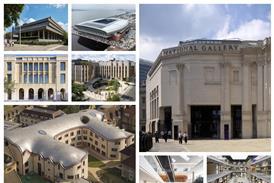With traditional institutions slow to change, it may be that the future of architectural education doesn’t lie in the schools at all, says Ben Flatman

The RIBA Education Review (RER) has now been underway since 2013. When I last commented on it nearly three years ago, the Brexit referendum had only just taken place and Barack Obama was still in the White House. A huge amount has changed in the world since then, and yet it seems that progress in education reform has been painfully slow. To try to understand what has been going on I reached out to the RIBA’s dogged director of education, David Gloster, who has been patiently overseeing the process.
When I first contacted Gloster back in 2016, the RER was still finalising its principal recommendations, which were eventually shared at the RIBA Education Forum in March 2017. The central proposal was the introduction of a “seven-year integrated award” that would enable “access to the register of architects and title of architect on successful completion of the integrated course”. Although the existing system had always allowed for registration within seven years, few ever achieved this, with most architects taking closer to 10 (or never registering). A clear and properly structured route to becoming an architect in a set seven-year period of time therefore clearly had the potential to make a lot of difference to students’ lives and career paths. But six years on from the initiation of the RER, where are all the new courses?
Six years on from the initiation of the RIBA Education Review, where are all the new courses?
In 2016 Gloster told me that: “Shifting the inertia around the existing system will take time.” Even then, this already sounded like an understatement. The current tripartite qualification system dates to the 1958 Oxford Conference, which had sought to introduce minimum standards, and a professional status equivalent to lawyers and doctors. But the nature of architectural practice had changed massively in the intervening decades. Many students were questioning what the schools were actually teaching – where were the opportunities to learn about construction, business and workplace management for those who wanted it? I still look back on my five years of full-time study and wonder how it was possible that we never set foot on a single building site. With the mounting student debt burden imposed by a drawn-out and increasingly redundant education process, it was hard to understand why things hadn’t changed sooner.
I still look back on my five years of full-time study and wonder how it was possible that we never set foot on a single building site
Although a small number of schools had already been experimenting with different course structures for several years, and were clearly keen on the idea of change, it felt like the education establishment in general was not fully engaged. I remember observing a meeting of the Standing Conference of Heads of Schools of Architecture (Schosa) in the early 2000s. When I asked some attendees whether Schosa would be discussing the shape of future education reform, I was met with incredulity – the establishment attitude at that time seemed to be that the Oxford Conference ”tripartite” system would stay in perpetuity.
Fortunately, the need for reform has now long been recognised. But it’s worth noting that in a similar period of time that it took the RER to deliver its recommendations, former BD editor Will Hunter not only conducted his own analysis of the challenges, but actually set up an entirely new school of architecture to help address them directly.
In 2016, I therefore questioned whether the changes being proposed by the RER were radical enough, and whether they were being implemented quickly enough to address rising student frustrations. Three years on, and it feels like many of these questions remain. If fully implemented, “registration on graduation” would represent substantive change, but the pace of even these modest reforms feels glacial.
The RER leaves the exact structure of the new seven-year integrated courses to the schools to decide, but according to Gloster, one of the most significant changes is the idea that the traditional Part 3 element would be integrated throughout, rather than tacked on at the end. And in order to try to ensure these changes are actually implemented, the RIBA had asked that schools of architecture to submit their new (or redesigned) course structures by September 1 this year for comment. However, according to David Gloster, only a third of schools have so far shared their proposals. This slow response suggests that the majority are still not fully engaged with the RER, a process which has been underway, in close consultation with educators, for six years. At what point, it seems fair to ask, will these other schools begin to inject some urgency into reform?
The role of architects is changing constantly, and yet to a large extent the educational system still remains unchanged from a model created in the late 1950s. In the current global climate, it is hard to make firm predictions about anything, but it seems very likely that architectural education will diverge into increasingly distinct strands. Architecture students are rightly demanding more flexibility and value for money. With the pace of technological and environmental change only increasing, review of the education system must become a constant process. The challenge will be to find a way forward that isn’t indefinitely held up by those who are uninterested in or even afraid of change. Some schools could just be left behind.
The challenge will be to find a way forward that isn’t indefinitely held up by those who are uninterested in or even afraid of change
When I put this point to David Gloster, he acknowledged that there was now a “self-evident” case that rather than occurring once every two or three generations, education reform needed to become something that took place on an ongoing basis. But he also highlighted the lack of engagement from the Architects Registration Board when pointing out that “change can and will only happen at the speed the slowest stakeholder pursues this.”
Meanwhile, the debate moves on. Since 2016, the RIBA has also been working on the introduction of a new Architectural Apprenticeship scheme, which promises to take architectural education “back to the future”, through practice-based apprenticeships that require only 20% of a student’s time to be spent in full-time study. Ironically, it was the old apprenticeship system that the 1958 reforms had sought to make redundant. Perhaps, then, the future of architectural education doesn’t lie in the schools at all.
















6 Readers' comments